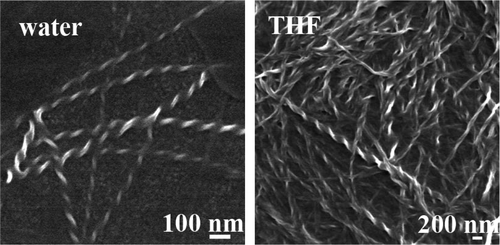Solvent-Induced Handedness Inversion of Dipeptide Sodium Salts Derived from Alanine
Yi Li , Baozong Li , Yitai Fu , Shuwei Lin , and Yonggang Yang * (杨永刚)
Jiangsu Key Laboratory of Advanced Functional Polymer Design and Application, Department of Polymer Science and Engineering, College of Chemistry, Chemical Engineering and Materials Science, Soochow University, Suzhou 215123, P. R. China
Langmuir, 2013, 29, 9721–9726.
The relationship between amino acid sequences and their resulting nanostructure has been well studied, but that between amino acid chirality and nanostructure handedness has not. Four dipeptide sodium salts with long alkyl chains derived from l- and d-alanines were synthesized. The behavior of their self-assembly into physical gels in water and THF was studied using field-emission scanning electron microscopy, circular dichroism (CD), FT-IR spectroscopy, 1H NMR spectroscopy, and X-ray diffraction. The dipeptide salts organized into twisted nanoribbons, whose handedness was controlled by the terminal alanine chirality. The handedness of nanoribbons formed in water was opposite to that of those formed in THF. The dipeptide salts self-assembled into similar interdigitated bilayer structures in water and THF, but CD spectra of the gels indicated that the stacking of carbonyl groups was opposite. The formation of this handedness inversion is proposed to arise from the difference in interlayer distance and chiral stacking of carbonyl groups near the C-terminals.

链接: //pubs.acs.org/doi/abs/10.1021/la402174w